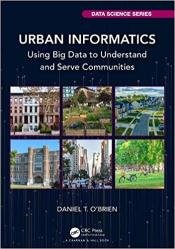 Название: Urban Informatics: Using Big Data to Understand and Serve Communities
Название: Urban Informatics: Using Big Data to Understand and Serve CommunitiesАвтор: Daniel T. O’Brien
Издательство: CRC Press
Серия: Data Science Series
Год: 2023
Страниц: 340
Язык: английский
Формат: pdf (true)
Размер: 53.4 MB
Urban Informatics: Using Big Data to Understand and Serve Communities introduces the reader to the tools of data management, analysis, and manipulation using R statistical software. Designed for undergraduate and above level courses, this book is an ideal onramp for the study of urban informatics and how to translate novel data sets into new insights and practical tools.
Each chapter has an Exploratory Data Assignment that prompts readers to practice their new skills on a data set of their choice. These assignments guide readers through the process of becoming familiar with the contents of a novel data set and communicating meaningful insights from the data to others.
R is an opensource, freeware program for working with data, especially focused on the production of professional quality analyses and visualizations. Freeware means that R is available for download at no cost for Windows, Mac OS, UNIX, and LINUX through the Comprehensive R Archive Network, or CRAN. Open source means that the underlying code is public and accessible to anyone who might want to work with it. Given its accessibility, R has grown a large community of users, including some of the world’s leading statisticians and methodologists. These users have contributed in many ways over the years, including debugging and suggesting improvements for R and developing and publishing thousands of packages that expand its capabilities. When statisticians develop a new tool for analysis or visualization, they often build it for R first, giving other R users access to cutting-edge techniques well before they have been incorporated into for-purchase softwares, like SPSS, SAS, or Stata. In addition, the R Foundation provides the funds necessary for basic maintenance of the software and CRAN, which is the public access point for the program and packages.
A lot has been made of machine learning in popular discourse. Even more is made of the ways that Artificial Intelligence (AI) is going to transform society. Alexa and Siri hear our voices, interpret our words, and serve up the desired information. Autonomous vehicles will change transportation as we know it by navigating streets and communicating with each other via WiFi. Investment strategies are now based on “bots” that predict good bets. In fact, many of those bots were designed by other bots. In response to this hype, some circles mock the vagary of machine learning and AI, as in the cartoon, which pokes fun at the idea that these tools are just fancy window dressing for traditional statistics. Who is right?
We can square the futuristic and critical perspectives on machine learning and AI by understanding two things. First, these techniques are based on traditional statistical tools. Second, they advance the power of these statistical tools by allowing the vast computational power of modern technology to determine and test the models. These two facts, respectively, explain both the hesitance and excitement. The computers can build models that are far more sophisticated than what a human would develop, a sophistication that can then build on itself to generate fundamentally distinct insights and products. But the statistical tests are still subject to the same weaknesses that we have seen throughout the book, including bias and overinterpretation, and the power of Machine Learning and AI will only amplify these issues and can accidentally encode them into the new technologies that have been hailed as so transformative.
Key Features:
The technical curriculum consists of both data management and analytics, including both as needed to become acquainted with and reveal the content of a new data set.
Content that is contextualized in real-world applications relevant to community concerns.
Unit-level assignments that educators might use as midterms or otherwise. These include Community Experience assignments that prompt students to evaluate the assumptions they have made about their data against real world information.
All data sets are publicly available through the Boston Data Portal.
Скачать Urban Informatics: Using Big Data to Understand and Serve Communities